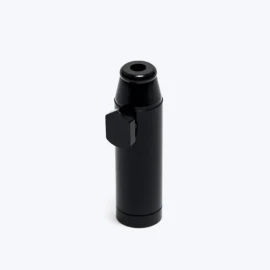Crazy Zkittles Autoflowering 5 plus 2 Pack
50,00 €
Why This Guide Matters
This comprehensive guide covers everything you need to know about Zkittlez autoflowering genetics, including realistic growing expectations, the value of our 5+2 seed pack, and essential safety considerations. Whether you’re a complete beginner or looking to expand your knowledge, you’ll find practical insights without overwhelming sales pressure—just honest education to help you make informed decisions.
What is “Zkittlez” (and “Crazy Zkittles”) Autoflowering?
Zkittlez autoflowering represents an indica-dominant hybrid renowned for its distinctive candy-sweet flavors and vibrant terpene profile. The “Crazy Zkittles” designation serves as a descriptive label highlighting the strain’s exceptional sweetness and potency, though it’s built on the established Zkittlez autoflowering genetics that growers have come to trust.
This strain emerges from careful breeding that combines the original Zkittlez lineage with ruderalis genetics, creating an indica-leaning variety that typically expresses an 80% indica / 20% sativa ratio. The autoflowering trait means these plants transition from vegetative growth to flowering based on age rather than light cycle changes, making them exceptionally beginner-friendly.
The autoflowering characteristic offers several key advantages: a compressed lifecycle of just 9–12 weeks from seed to harvest, no need for complex light schedule adjustments, and a naturally compact stature perfect for small spaces. Ideal if you want fast results and candy-like flavor without complex light schedules.
The 5+2 Pack — Maximum Value and Learning Opportunities
Our 5+2 pack means you purchase five premium Zkittlez autoflowering seeds and receive two additional bonus seeds at no extra cost. This configuration provides exceptional value for both new and experienced growers seeking to maximize their investment.
Benefits of Extra Seeds
More Germination Attempts: Even premium seeds occasionally fail to germinate due to various factors. Having seven seeds instead of five significantly increases your chances of achieving successful grows, especially important for beginners still mastering germination techniques.
Experimentation Opportunities: Use bonus seeds to test different growing techniques, compare indoor versus outdoor cultivation, or experiment with training methods without risking your main crop.
Risk Reduction: For beginners, additional seeds provide peace of mind. You can approach your first grows with confidence, knowing that germination failures or early mistakes won’t end your growing experience.
Sharing and Gifting: Extra seeds allow experienced growers to share with friends or family members interested in cultivation, fostering community knowledge and supporting legal home growing initiatives.
Proper Seed Storage
Store your seeds in cool, dark, dry conditions—ideally in a refrigerator in airtight containers with silica gel packets. Label containers with strain names and purchase dates. Properly stored seeds maintain viability for several years, making your 5+2 pack a long-term investment in your growing journey.
Understanding Seed Types — Autoflower vs. Feminized vs. Photoperiod
Autoflowering Seeds
Plants flower automatically based on age (typically 3–5 weeks), require consistent light schedules (18–24 hours daily), offer shorter lifecycles (9–12 weeks total), limited training options, and excellent beginner friendliness.
Feminized Seeds
Bred to produce 99%+ female plants, may be autoflowering or photoperiod varieties, eliminate the need to identify and remove male plants, and maximize space efficiency since all plants produce flowers.
Photoperiod Seeds
Flower only when light cycles change (typically 12/12 hours), allow extended vegetative periods for larger plants, support aggressive training techniques, require more complex light management, and suit experienced growers seeking maximum yields.
Quick Comparison
| Feature | Autoflower | Photoperiod | Beginner Rating |
|---|---|---|---|
| Light Management | Simple (18+ hrs) | Complex (12/12 switch) | Auto: ⭐⭐⭐⭐⭐ |
| Veg Control | Limited | Full control | Photo: ⭐⭐⭐ |
| Total Lifecycle | 9–12 weeks | 14–20+ weeks | |
| Training Suitability | LST only | All methods | |
| Space Requirements | Compact | Variable |
Buyer Guidance: Choose autoflowers for speed, simplicity, and small spaces. Select photoperiods for maximum control, aggressive training, and larger yields when space and time allow.
Plant Profile & Laboratory Data — What to Expect
Cannabinoid Profile
THC Content: Zkittlez autoflowering typically produces 18–22% THC, with some exceptional phenotypes reaching up to 25% under optimal conditions. This potency range provides substantial psychoactive effects suitable for both recreational and therapeutic applications.
CBD Levels: Generally low CBD content (usually under 1%), making this strain primarily THC-dominant rather than balanced or CBD-focused.
Terpene Composition
The distinctive Zkittlez flavor profile comes from its rich terpene content:
Myrcene: Contributes to the strain’s relaxing, sedative qualities and enhances the overall “couch-lock” effect associated with indica-dominant varieties.
Limonene: Provides bright citrus notes and may contribute to mood elevation and stress relief.
Caryophyllene: Adds spicy, peppery undertones and may offer anti-inflammatory properties.
Effects and User Experience
The 80% indica / 20% sativa ratio translates to primarily physical relaxation with mild cerebral stimulation. Users typically report:
Initial Effects: Euphoric mood lift, stress relief, and gentle cerebral stimulation from the sativa influence.
Peak Experience: Deep physical relaxation, muscle tension relief, and a sense of calm contentment.
Later Session: Increased sedation, appetite stimulation, and potential sleepiness, making this strain excellent for evening use.
User Profile: Best suited for stress relief, pain management, insomnia, and appetite stimulation. Low reported incidence of anxiety or paranoia makes it beginner-friendly for THC tolerance building.
Growth Timeline & Yield Expectations
Key Growing Specifications
Total Lifecycle: 9–12 weeks from germination to harvest, making it ideal for quick turnarounds and multiple annual crops.
Plant Height: Compact 80–100 cm stature suits small indoor spaces, balconies, and discrete outdoor growing.
Indoor Yields: 350–500 grams per square meter under optimal conditions with proper lighting, nutrition, and environmental controls.
Outdoor Yields: 90–120 grams per plant in suitable climates with adequate sunlight and protection from extreme weather.
Environmental Suitability
Indoor Growing: Thrives in small tents and cabinets. Excellent for Sea of Green (SOG) setups where multiple small plants maximize space efficiency. LED lighting provides ideal spectrum control and heat management.
Outdoor Cultivation: Performs best in temperate to Mediterranean climates. Hardy enough for variable weather conditions but requires protection from extended cold or excessive humidity. Perfect for short growing seasons where photoperiod strains wouldn’t have time to complete their lifecycle.
Week-by-Week Timeline
Weeks 0–1: Germination and seedling establishment. Focus on gentle conditions and minimal intervention.
Weeks 1–3: Rapid vegetative growth. Plants develop true leaves and establish root systems. Begin light feeding schedules.
Weeks 3–5: Continued vegetative expansion with pre-flowering signs. Maintain consistent lighting and gradually increase nutrients.
Weeks 5–7: Early flowering development. Pistils appear and flower sites multiply. Begin flowering nutrients and monitor humidity.
Weeks 7–10: Peak flower development. Buds swell and trichome production accelerates. Maintain stable conditions.
Weeks 10–12: Final ripening and harvest preparation. Monitor trichomes for optimal harvest timing.
Who Should Try Crazy Zkittles?
Ideal Candidates
Absolute Beginners: The forgiving nature of autoflowering genetics combined with Zkittlez stability makes this an excellent first strain. Short lifecycle means faster learning cycles and quicker feedback on growing techniques.
Space-Constrained Growers: Compact plants suit small indoor setups, balconies, or areas where discretion matters. No need for separate vegetative and flowering spaces.
Fast-Cycle Enthusiasts: Growers wanting multiple harvests per year or quick turnaround for continuous supply appreciate the 9–12 week lifecycle.
Flavor Seekers: The distinctive candy-sweet terpene profile appeals to users prioritizing taste and aroma over maximum potency.
Key Benefits
Speed and Simplicity: No complex light schedules or timing considerations. Plants grow and flower automatically with minimal intervention.
Manageable Size: 80–100 cm height suits most indoor spaces without requiring extensive training or height management.
Excellent Yields: Despite compact size, produces substantial harvests relative to plant stature and growing time investment.
Sweet Flavor Profile: Distinctive candy-like taste and aroma provide exceptional smoking or vaping experiences.
Considerations and Challenges
Limited Training Options: Autoflowers respond poorly to high-stress techniques like topping. Low-stress training (LST) and defoliation work best.
Stress Sensitivity: Early weeks are crucial—major stress during vegetative growth can significantly impact final yields.
Sedative Effects: High indica content produces relaxing, potentially sedating effects that may not suit users needing energy or mental clarity.
Time Pressure: Short lifecycle leaves little room for recovery from mistakes. Successful autoflower growing requires consistency and planning.
Complete Beginner Growing Checklist
Pre-Planting Preparation
Legal Compliance: Research local laws regarding seed possession, plant cultivation, and cannabis use. Ensure full compliance with regional regulations.
Space Planning: Choose appropriate growing location—indoor tent, spare room, outdoor garden, or balcony. Ensure adequate ventilation, lighting access, and privacy.
Equipment Gathering: Assemble basic supplies including pots (3–5 gallons recommended), quality growing medium, pH testing kit, basic nutrients, and lighting system for indoor grows.
Germination (Days 0–4)
Method Selection: Paper towel method, direct sowing, or rapid rooter plugs all work effectively. Maintain 20–25°C temperature for optimal germination rates.
Environment: Dark, warm, humid conditions promote faster germination. Check daily for taproot emergence.
Transplanting: Move germinated seeds to final containers once taproots reach 1–2 cm length. Handle gently to avoid damage.
Seedling Care (Weeks 1–3)
Lighting: Provide 18–24 hours daily light for indoor autoflowers. Use gentle intensity initially to avoid light stress.
Watering: Light, frequent watering around the seedling. Avoid overwatering which can cause damping-off and root problems.
Nutrition: Begin feeding only after true leaves appear. Start with quarter-strength nutrients and gradually increase.
Vegetative to Flowering (Weeks 3–7)
Light Consistency: Maintain 18+ hour lighting schedules. Avoid extended dark periods which can trigger premature flowering.
Training Techniques: Apply low-stress training (LST) to improve light penetration and increase yield potential. Avoid topping autoflowers.
Feeding Schedule: Follow mild, gradual nutrient increases. Monitor plants for deficiency or toxicity signs and adjust accordingly.
Late Flowering & Harvest (Weeks 7–12)
Environmental Control: Reduce humidity to 40–50% to prevent mold and mildew during dense flower development.
Trichome Monitoring: Use jeweler’s loupe or microscope to check trichome development. Harvest when trichomes shift from clear to cloudy/amber depending on desired effects.
Flushing: Consider final week plain water flushing to improve flavor, though this practice varies among growers.
Post-Harvest Processing
Drying: Hang harvested plants in dark, well-ventilated space at 18–21°C with 45–55% humidity for 7–14 days.
Curing: Place dried flowers in airtight jars, opening daily for first week then weekly. Proper curing improves flavor and potency over 2–6+ weeks.
Common Problems and Solutions
Overwatering Issues
Symptoms: Drooping leaves, yellowing, slow growth, and potentially root rot in severe cases.
Solutions: Allow soil to dry between waterings, improve drainage with perlite additions, and reduce watering frequency.
Nutrient Problems
Deficiency Signs: Yellowing leaves, slow growth, or purple stems may indicate insufficient nutrition.
Toxicity Symptoms: Nutrient burn appears as brown leaf tips, curling, or dark green coloration.
Corrections: Adjust feeding schedules gradually, test and adjust pH to 6.0–7.0 range, and flush if toxicity occurs.
Light Stress
Symptoms: Bleaching, yellowing top leaves, or stunted growth despite adequate nutrition.
Solutions: Increase distance between lights and plants, reduce daily light hours slightly, or decrease light intensity.
Pest and Disease Management
Prevention: Maintain clean growing environment, inspect plants regularly, and ensure adequate airflow.
Organic Controls: Neem oil for soft-bodied insects, beneficial predator insects for ongoing management, and proper sanitation practices.
Low Yield Issues
Common Causes: Small containers restricting root development, insufficient lighting, overfeeding or underfeeding, and environmental stress.
Solutions: Use appropriately sized containers (3–5 gallons minimum), ensure adequate light coverage, maintain consistent feeding schedules, and minimize plant stress.
Sustainable Growing Practices
Energy Efficiency
LED Advantages: Modern LED systems use 40–60% less electricity than traditional HPS lighting while producing superior spectrum control and reduced heat generation.
Timer Optimization: Consistent 20-hour light schedules often provide optimal results for autoflowers while reducing energy consumption compared to 24-hour lighting.
Water Conservation
Efficient Systems: Drip irrigation and self-watering containers reduce water waste while maintaining consistent moisture levels.
Runoff Management: Collect and reuse nutrient runoff when possible, though always test pH and nutrient levels before reapplication.
Soil and Waste Reduction
Living Soil: Organic soil amendments and compost teas reduce synthetic nutrient requirements while improving soil biology.
Container Reuse: Choose durable, washable pots that last multiple growing cycles. Many fabric pots withstand years of use with proper care.
Recycling: Properly dispose of seed packaging and nutrient containers through appropriate recycling programs.
Small-Footprint Strategies
Micro-Greenhouses: Small greenhouse structures extend outdoor growing seasons while protecting plants from weather extremes.
Vertical Growing: Utilize vertical space with multiple shelf systems for increased plant capacity in limited floor space.
Strain Comparisons
Zkittlez Auto vs. Gelato Auto
Flavor Profile: Zkittlez offers candy-sweet fruity flavors while Gelato provides creamy, dessert-like tastes with berry undertones.
Potency: Both strains typically range 18–23% THC, with Gelato sometimes reaching slightly higher peaks.
Effects: Zkittlez leans more sedating (indica-dominant) while Gelato provides more balanced cerebral and physical effects.
Zkittlez Auto vs. Northern Lights Auto
Growing Difficulty: Both excellent for beginners, but Northern Lights has slight edge for absolute novices due to extreme hardiness.
Flavor: Zkittlez provides sweet, fruity flavors while Northern Lights offers earthy, pine, and sweet undertones.
Sedative Effects: Northern Lights generally produces stronger sedative effects, making Zkittlez better for users wanting relaxation without heavy couch-lock.
Zkittlez Auto vs. Fast-Finishing Autos
Speed: Some autoflowers finish in 7–9 weeks compared to Zkittlez’s 9–12 week timeline.
Yield Trade-offs: Faster strains often sacrifice yield potential for speed, while Zkittlez balances reasonable timeline with solid production.
Flavor Development: Longer flowering period allows more complex terpene development in Zkittlez.
Consumption and Safety Guidelines
Consumption Methods
Smoking: Immediate onset (2–10 minutes) with peak effects lasting 1–3 hours. Provides full flavor profile and rapid dose control.
Vaporizing: Cleaner consumption method with similar onset timing but potentially extended duration. Better flavor preservation and reduced respiratory irritation.
Edibles: When using harvested flower for cooking, expect 30–120+ minute onset with effects lasting 4–8 hours. Start with minimal amounts due to delayed onset.
Dosing for New Users
Inhalation: Begin with single small inhale, wait 15 minutes, assess effects before continuing. THC tolerance builds gradually.
Edible Preparations: If making edibles, start with doses equivalent to 1–2.5 mg THC and wait full onset period before additional consumption.
Common Side Effects
Typical Reactions: Dry mouth, dry eyes, increased appetite, mild dizziness, and relaxation progressing to sleepiness.
Management: Stay hydrated, have eye drops available, prepare snacks in advance, and plan for relaxing environment.
Safety Considerations
Medical Interactions: Consult healthcare providers about potential interactions with medications, especially sedatives, antidepressants, or blood thinners.
Impairment Warning: Do not drive, operate machinery, or engage in activities requiring alertness while under influence.
Age Restrictions: Products intended for adults 21+ in legal jurisdictions. Keep away from children and pets.
Legal and Shipping Considerations
Regional Legal Overview
United States: Laws vary significantly by state. Many states allow personal cultivation with plant limits, while others maintain prohibition. Seeds may face restrictions crossing state lines.
Canada: Federally legal for adults with provincial regulations governing cultivation limits, typically 4 plants per household.
European Union: Varies by country. Some nations allow seed sales but prohibit cultivation, while others maintain full prohibition. Research specific country laws.
Australia: Highly regulated with most states maintaining prohibition. Limited medical access programs exist in some regions.
Shipping and Storage
Reputable Sources: Choose established seed banks with germination guarantees and discrete shipping practices.
Customs Considerations: International shipping may face customs inspection. Understand import regulations for your region.
Documentation: Keep purchase records and understand local possession limits if applicable in your jurisdiction.
Legal Disclaimer: This information is educational only and not legal advice. Laws change frequently—always verify current regulations in your specific location before purchasing, possessing, or cultivating cannabis seeds or plants.
Frequently Asked Questions
How long does Zkittlez autoflower take to harvest?
Complete lifecycle ranges 9–12 weeks from germination to harvest, depending on growing conditions and phenotype variation.
What yields can I expect indoors and outdoors?
Indoor yields typically range 350–500 g/m² while outdoor plants produce 90–120 grams each under optimal conditions.
Is Zkittlez autoflower good for beginners?
Yes, excellent beginner choice due to forgiving genetics, automatic flowering, compact size, and relatively short growing cycle.
Can I top Zkittlez autoflower plants?
Not recommended. Autoflowers respond poorly to high-stress training. Use low-stress training (LST) and gentle defoliation instead.
What does 19% THC / 80% Indica / 20% Sativa mean?
THC percentage indicates potency level. The indica/sativa ratio suggests primarily relaxing physical effects (indica) with mild cerebral stimulation (sativa).
How should I store seeds and cured flower?
Store seeds in cool, dark, dry conditions with silica packets. Cure flower in airtight containers, opening regularly for first weeks.
Are there common side effects?
Typical effects include dry mouth, increased appetite, relaxation, and potential sleepiness. Generally well-tolerated with low anxiety reports.
Is it legal to buy and grow seeds in my country?
Laws vary significantly worldwide. Research local regulations regarding seed possession, plant cultivation, and cannabis use before purchasing.
Summary and Next Steps
Zkittlez autoflowering represents an ideal introduction to cannabis cultivation, combining beginner-friendly genetics with exceptional flavor and reasonable potency. The 5+2 seed pack provides excellent value and learning opportunities for new growers while offering experienced cultivators chances to experiment and share.
This strain particularly suits growers seeking fast results, compact plants, and distinctive sweet flavors without complex cultivation requirements. The 9–12 week lifecycle allows multiple annual harvests while the stable genetics forgive common beginner mistakes.
Next Steps: Review the comparison table to understand how Zkittlez fits your specific needs, download our week-by-week checklist for easy reference, explore community grow diaries for real-world insights, and verify legal compliance in your jurisdiction before proceeding.
Important Reminders: Always check local laws regarding seed possession and plant cultivation. Consult healthcare professionals for medical applications or medication interactions. This guide provides educational information—growing success depends on consistent application of proper techniques and environmental management.
Related Products
Frequently Asked Questions
Everything You Need to Know















